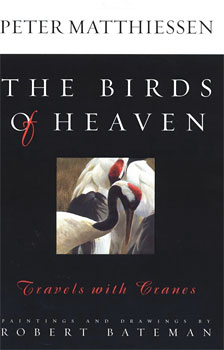| book recommendation

The Birds of Heaven:
Travels with Cranes
by Peter Matthiessen
In an interview with Richard Powers, he mentioned reading The Birds of Heaven in reading about cranes for his book The Echo Maker. It had been a long time since I had read any Peter Matthiessen. It was time to rectify that situation. From Amazon:
|
Acclaimed writer Peter Matthiessen, a self-professed "craniac," has been observing and studying all kinds of birds most of his life, but his pursuit of cranes is closer to a spiritual quest than a naturalist's exercise. These majestic, mythic, and notoriously shy birds, capable of soaring at heights of 20,000 feet, are often fond of remote and rugged places, so just locating the birds can be difficult enough, determining an accurate number often impossible. Some locales, such as the breeding grounds on the Platte River in Nebraska, boast flocks half a million strong--"by far the greatest crane assemblies on earth"; other areas support only a precious few. Matthiessen's search for 15 different species of cranes has taken him to hidden corners of Siberia, China, Mongolia, Tibet, Sudan, and Australia (where Atherton cranes were not even discovered until 1961). Despite his many years of adventure and wide travels, each crane sighting is still a thrill for him, and his curiosity and contagious enthusiasm bring the book alive. But The Birds of Heaven also serves as an ecological warning: "Perhaps more than any other living creatures, they evoke the retreating wilderness, the vanishing horizons of clean water, earth, and air upon which their species--and ours, too, though we learn it very late--must ultimately depend for survival."
| |
Understanding Cranes Means Understanding Everything
Here is an excerpt:
Peter Matthiessen
The Birds of Heaven: Travels With Cranes
|
On a rare clear morning -- the first day of summer 1992 -- flying across the Bering Strait from the Yukon delta toward the Diomede Islands and the Chukotskiy Peninsula of Siberia, I imagine the gray sun-silvered strait as seen from on high by a migrating crane, more particularly, by the golden eye of the Crane from the East, as the lesser sandhill crane of North America is known to traditional peoples on its westernmost breeding territory in Siberia. The sandhill commonly travels a mile above the earth and can soar higher, to at least twenty thousand feet -- not astonishing when one considers that the Eurasian and demoiselle cranes ascend to three miles above sea level traversing the Himalaya in their north and south migrations between Siberia and the Indian subcontinent.
That cranes may journey at such altitudes, disappearing from the sight of earthbound mortals, may account for their near-sacred place in the earliest legends of the world as messengers and harbingers of highest heaven. In Cree Indian legend, Crane carries Rabbit to the moon. Aesop extols the crane's singular ability "to rise above the clouds into endless space, and survey the wonders of the heavens, as well as of the earth beneath, with its seas, lakes, and rivers, as far as the eye can reach," and Homer and Aristotle comment on great crane migrations. Every land where they appear has tales and myths about the cranes, which since ancient times have represented longevity and good fortune, harmony and fidelity. Heaven-bound ancients are commonly depicted riding on a crane, or assuming the crane's majestic form for their arrival in the clouds of immortality.
The larger cranes, over five feet tall, with broad strong wings eight feet in span, appear well capable of bearing aloft a wispy old-time sage. The cranes are the greatest of the flying birds and, to my mind, the most stirring, not less so because the horn notes of their voices, like clarion calls out of the farthest skies, summon our attention to our own swift passage on this precious earth. Perhaps more than any other living creatures, they evoke the retreating wilderness, the vanishing horizons of clean water, earth, and air upon which their species -- and ours, too, though we learn it very late -- must ultimately depend for survival.
| |
[more]
Peter Matthiessen
|

